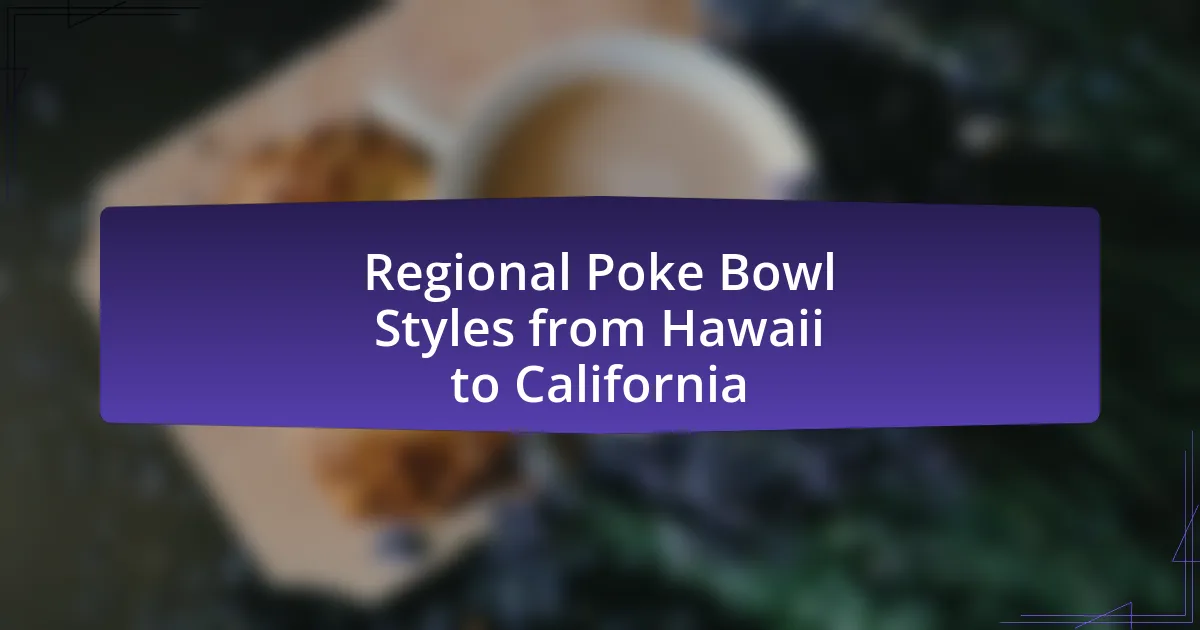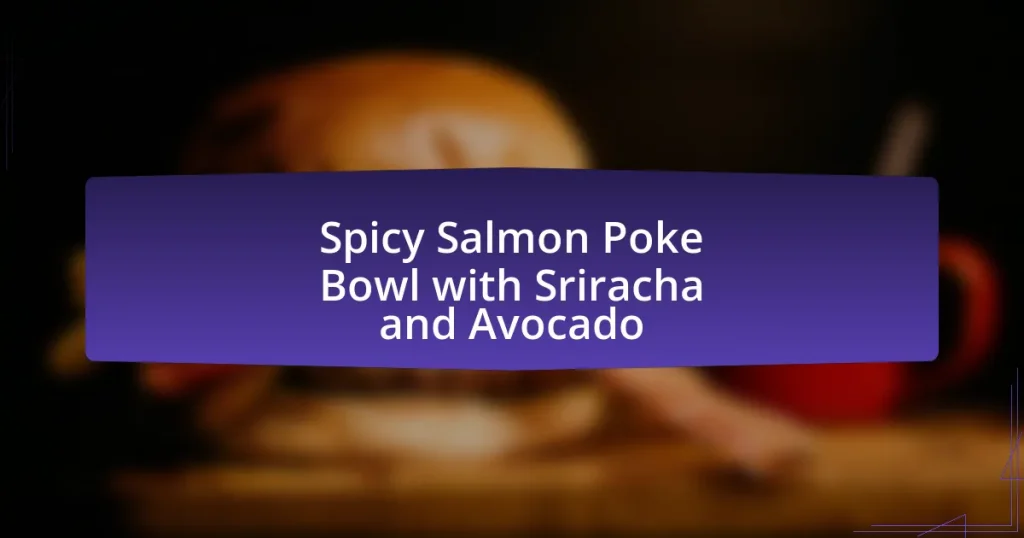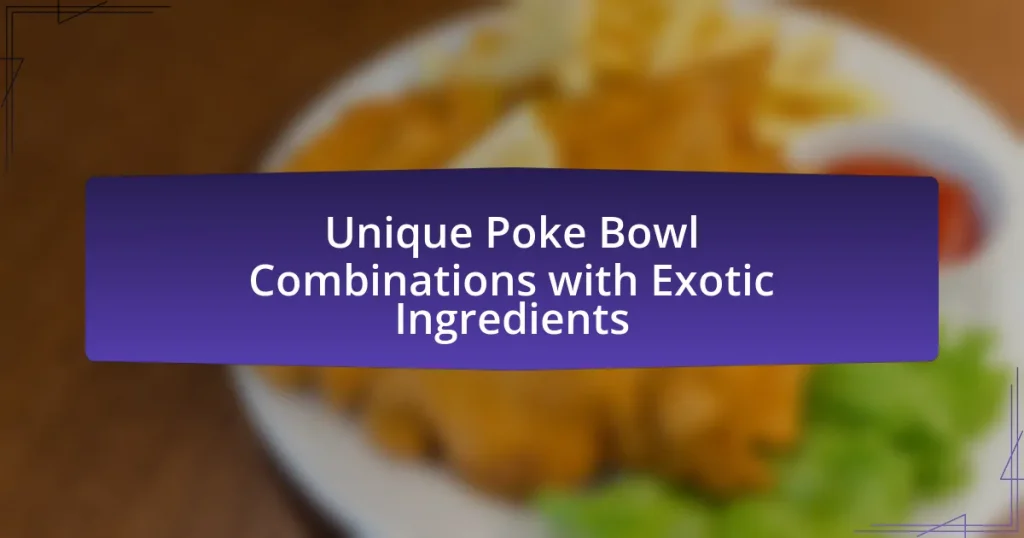The article explores the evolution of poke bowls from their origins in Hawaii to their adaptation in California. It details the traditional Hawaiian poke, which consists of diced raw fish seasoned with local ingredients, and how it has evolved to incorporate multicultural influences and diverse toppings. The article also examines regional variations within Hawaii, the transition of poke to California, and the factors contributing to its popularity, including health trends and fusion styles. Additionally, it highlights key differences between Hawaiian and Californian poke bowls, including ingredient choices and flavor profiles, while providing tips for creating poke bowls at home.

What are the origins of poke bowls in Hawaii?
Poke bowls originated in Hawaii as a traditional dish made from diced raw fish, typically ahi tuna, seasoned with various ingredients. The dish has roots in Native Hawaiian fishing practices, where fishermen would cut up their catch and season it with sea salt, seaweed, and other local ingredients. Over time, poke evolved to include a variety of toppings and flavors, reflecting the multicultural influences in Hawaii, including Japanese, Chinese, and Korean cuisines. This evolution has led to poke bowls becoming a popular dish not only in Hawaii but also in mainland United States, particularly California, where they have been adapted to include a wider range of ingredients and styles.
How did traditional Hawaiian poke evolve over time?
Traditional Hawaiian poke evolved from a simple dish of raw fish seasoned with sea salt and inamona (a condiment made from roasted kukui nuts) to a more diverse array of ingredients and flavors influenced by various cultures. Initially, poke was primarily made with local fish like aku (skipjack tuna) and was a staple in Hawaiian cuisine, reflecting the island’s fishing traditions. Over time, as Hawaii became more interconnected with the mainland United States and other cultures, poke began to incorporate additional ingredients such as soy sauce, sesame oil, and a variety of toppings like avocado, seaweed, and even spicy mayonnaise. This evolution was further accelerated by the popularity of poke bowls in California, where chefs experimented with fusion styles, leading to a broader acceptance and adaptation of poke beyond its traditional roots.
What ingredients are typically used in traditional Hawaiian poke?
Traditional Hawaiian poke typically includes fresh raw fish, commonly ahi (yellowfin tuna) or octopus, along with ingredients such as soy sauce, sesame oil, green onions, and sea salt. These ingredients create a flavorful and authentic dish that reflects Hawaiian culinary traditions. The use of fresh fish is essential, as poke originated as a way to utilize the abundant seafood available in Hawaii, making it a staple in local cuisine.
How do cultural influences shape Hawaiian poke recipes?
Cultural influences shape Hawaiian poke recipes by integrating diverse culinary traditions and ingredients from various ethnic groups in Hawaii. The original poke, rooted in Native Hawaiian practices, has evolved through the incorporation of Asian flavors, particularly from Japanese, Chinese, and Korean cuisines, which introduced elements like soy sauce, sesame oil, and pickled vegetables. This fusion reflects Hawaii’s multicultural society, where local ingredients such as fresh fish, seaweed, and tropical fruits are combined with these international flavors, resulting in a unique and varied poke experience. The adaptation of poke recipes showcases the blending of cultural identities and the importance of community in Hawaiian food traditions.
What regional variations exist within Hawaii?
Hawaii exhibits regional variations characterized by differences in local ingredients, preparation methods, and cultural influences. For instance, the Big Island is known for its use of fresh, locally sourced fish and unique seasonings, while Oahu often incorporates a mix of traditional and modern flavors, reflecting its diverse population. Additionally, Maui tends to emphasize a more fusion-style poke, blending Hawaiian traditions with influences from Asian cuisines. These variations are rooted in the islands’ distinct ecosystems, cultural histories, and the availability of local resources, which shape the unique styles of poke bowls found across Hawaii.
How do different islands in Hawaii influence poke styles?
Different islands in Hawaii influence poke styles through their unique local ingredients and cultural practices. For example, the Big Island is known for its use of fresh, locally sourced fish and traditional seasonings like sea salt and limu (seaweed), which create a distinct flavor profile. In contrast, Oahu often incorporates a variety of toppings, such as avocado and spicy mayo, reflecting a more modern and diverse culinary approach. Additionally, Maui’s poke may feature tropical fruits like mango, showcasing the island’s agricultural bounty. These regional variations highlight how local resources and cultural influences shape the preparation and presentation of poke across the Hawaiian Islands.
What unique ingredients are found in specific Hawaiian poke bowls?
Unique ingredients found in specific Hawaiian poke bowls include fresh fish varieties such as ahi (yellowfin tuna) and ono (wahoo), along with traditional seasonings like shoyu (soy sauce), sesame oil, and sea salt. Additionally, poke bowls often feature toppings like limu (seaweed), kukui nuts, and fresh vegetables such as avocado and green onions. These ingredients reflect the cultural heritage of Hawaii, where poke originated, emphasizing the use of local seafood and flavors.

How did poke bowls transition to California?
Poke bowls transitioned to California primarily through the influence of Hawaiian culture and the growing popularity of Hawaiian cuisine on the mainland. In the 1970s, Hawaiian immigrants began introducing poke to California, particularly in areas with significant Hawaiian populations, such as Los Angeles and San Francisco. The dish gained further traction in the 2000s as health-conscious consumers sought fresh, customizable meal options, leading to the establishment of numerous poke restaurants across the state. By 2016, the poke bowl trend had exploded in California, with over 200 poke shops reported in the Los Angeles area alone, reflecting a significant cultural and culinary shift.
What factors contributed to the popularity of poke in California?
The popularity of poke in California is primarily attributed to its health-conscious appeal, cultural influences, and the rise of food trends emphasizing fresh, customizable meals. The health benefits of poke, which typically features raw fish, vegetables, and whole grains, align with California’s focus on nutritious eating. Additionally, the state’s diverse population, particularly its significant Hawaiian community, has facilitated the introduction and acceptance of poke as a mainstream dish. The trend of build-your-own meal concepts has further enhanced poke’s popularity, allowing consumers to personalize their bowls with various toppings and sauces. These factors collectively contribute to poke’s status as a favored culinary option in California.
How has the California culinary scene embraced poke bowls?
The California culinary scene has embraced poke bowls by integrating them into a diverse array of dining experiences, reflecting the state’s multicultural influences. This integration is evident in the proliferation of poke bowl restaurants across California, particularly in urban areas like Los Angeles and San Francisco, where the dish has become a popular choice for health-conscious consumers. The California poke bowl often features locally sourced ingredients, such as avocados and seasonal vegetables, alongside traditional elements like fresh fish and rice, showcasing a blend of Hawaiian roots and Californian innovation. Additionally, the rise of customizable poke bowl options allows diners to tailor their meals to personal preferences, further solidifying poke bowls as a staple in California’s culinary landscape.
What role do food trends play in the evolution of poke in California?
Food trends significantly influence the evolution of poke in California by driving its popularity and adaptation to local tastes. The rise of health-conscious eating and the demand for fresh, customizable meals have led to poke becoming a staple in California’s culinary scene. For instance, the incorporation of local ingredients, such as avocados and various sauces, reflects California’s diverse food culture and consumer preferences. Additionally, the trend towards sustainable seafood has prompted poke establishments to source fish responsibly, aligning with the values of environmentally aware consumers. This evolution is evidenced by the proliferation of poke restaurants across California, which cater to the growing interest in both traditional and innovative poke variations.
What are the key differences between Hawaiian and Californian poke bowls?
Hawaiian poke bowls primarily feature raw fish, typically ahi tuna, marinated in soy sauce, sesame oil, and green onions, while Californian poke bowls often incorporate a wider variety of ingredients, including cooked seafood, vegetables, and unique sauces like spicy mayo. The traditional Hawaiian poke emphasizes simplicity and freshness, reflecting its cultural roots, whereas Californian poke adapts to local tastes by offering diverse toppings such as avocado, mango, and various dressings. This evolution in style showcases the influence of California’s culinary innovation on the classic Hawaiian dish.
How do ingredient choices differ between the two regions?
Ingredient choices in poke bowls differ significantly between Hawaii and California. In Hawaii, traditional poke bowls typically feature fresh raw fish, such as ahi tuna or salmon, seasoned with soy sauce, sesame oil, and green onions, reflecting local fishing practices and cultural preferences. In contrast, California poke bowls often incorporate a wider variety of ingredients, including cooked seafood, avocado, and a range of toppings like spicy mayo or sriracha, catering to diverse dietary preferences and fusion influences. This divergence highlights Hawaii’s emphasis on authenticity and simplicity, while California’s approach embraces innovation and customization.
What flavor profiles are emphasized in Californian poke bowls?
Californian poke bowls emphasize fresh, vibrant flavor profiles that often include citrus, umami, and a variety of textures. Ingredients such as avocado, mango, and sesame oil are commonly used to enhance the overall taste experience. The incorporation of local produce and innovative toppings, like spicy mayo and wasabi, further diversifies the flavor palette, making it distinct from traditional Hawaiian poke. This approach reflects California’s culinary trend of blending fresh, seasonal ingredients with bold flavors, appealing to a health-conscious and adventurous dining audience.

What are the most popular poke bowl styles in California?
The most popular poke bowl styles in California include the traditional Ahi Tuna poke, Spicy Tuna poke, and Salmon poke. Ahi Tuna poke is favored for its fresh, high-quality fish, often marinated in soy sauce and sesame oil. Spicy Tuna poke typically features a blend of tuna with spicy mayo, appealing to those who enjoy a kick. Salmon poke is popular for its rich flavor and versatility, often paired with various toppings like avocado and seaweed salad. These styles reflect California’s emphasis on fresh ingredients and diverse flavor profiles, aligning with the state’s culinary trends.
How do California poke bowls incorporate local ingredients?
California poke bowls incorporate local ingredients by utilizing fresh, seasonal produce and seafood sourced from the Pacific coast. This approach emphasizes the use of avocados, which thrive in California’s climate, and locally caught fish such as yellowtail and salmon, ensuring freshness and sustainability. Additionally, California poke bowls often include ingredients like seaweed, radishes, and citrus, reflecting the region’s agricultural diversity and culinary trends. The incorporation of these local elements not only enhances flavor but also supports local farmers and fisheries, aligning with California’s farm-to-table ethos.
What are some signature toppings found in Californian poke bowls?
Signature toppings found in Californian poke bowls include avocado, spicy mayo, and sesame seeds. These toppings reflect California’s culinary influences, emphasizing fresh and vibrant ingredients. Avocado adds creaminess, spicy mayo provides a kick, and sesame seeds contribute a nutty flavor, enhancing the overall taste profile of the dish.
How do health trends influence poke bowl customization in California?
Health trends significantly influence poke bowl customization in California by driving demand for fresh, nutritious ingredients and plant-based options. As consumers increasingly prioritize health and wellness, poke bowl offerings have adapted to include more organic vegetables, whole grains, and sustainable seafood choices. For instance, a survey by the California Department of Public Health indicated that 70% of Californians are more likely to choose meals that are low in calories and high in nutrients, prompting poke bowl restaurants to feature customizable options that cater to these preferences, such as quinoa instead of rice and a variety of greens. This shift reflects a broader trend towards healthier eating habits, which has reshaped the traditional poke bowl into a more health-conscious meal option.
What fusion styles have emerged in California’s poke scene?
California’s poke scene has seen the emergence of several fusion styles, including Asian-inspired, Mexican, and Mediterranean variations. Asian-inspired poke often incorporates ingredients like kimchi, wasabi, and sesame oil, reflecting influences from Japanese and Korean cuisines. Mexican fusion styles introduce elements such as chipotle sauce, avocado, and cilantro, creating a unique blend of flavors. Mediterranean variations may include ingredients like olives, feta cheese, and tzatziki sauce, showcasing the versatility of poke beyond its traditional Hawaiian roots. These fusion styles highlight California’s diverse culinary landscape and the innovative approaches to poke preparation.
How do Asian influences manifest in Californian poke bowls?
Asian influences manifest in Californian poke bowls primarily through the incorporation of traditional Asian ingredients and flavor profiles. Ingredients such as soy sauce, sesame oil, and seaweed are commonly used, reflecting Japanese culinary traditions. Additionally, the use of fresh fish, particularly ahi tuna and salmon, aligns with the sashimi practices found in Japanese cuisine. The toppings often include pickled vegetables, avocado, and spicy mayo, which are inspired by various Asian cuisines, enhancing the overall flavor and texture of the dish. This fusion showcases a blend of cultural elements, making Californian poke bowls a unique representation of Asian culinary influence in a regional context.
What innovative combinations are popular among California poke enthusiasts?
Innovative combinations popular among California poke enthusiasts include spicy tuna with avocado and mango, salmon with wasabi aioli and crispy onions, and tofu with sesame dressing and seaweed salad. These combinations reflect California’s emphasis on fresh, high-quality ingredients and diverse flavor profiles. The use of tropical fruits like mango and avocado enhances the traditional poke experience, while unique sauces and toppings add a modern twist, catering to local tastes and preferences.
What are some tips for creating the perfect poke bowl at home?
To create the perfect poke bowl at home, start with high-quality, fresh fish such as ahi tuna or salmon, as freshness is crucial for flavor and safety. Next, choose a base like sushi rice or mixed greens, which provides a satisfying foundation. Incorporate a variety of toppings, including diced avocado, seaweed salad, and pickled vegetables, to enhance texture and taste. Drizzle with a flavorful sauce, such as soy sauce or spicy mayo, to tie the ingredients together. Finally, garnish with sesame seeds or green onions for added flavor and visual appeal. These elements combine to create a balanced and delicious poke bowl, reflecting the traditional Hawaiian style while allowing for personal customization.



